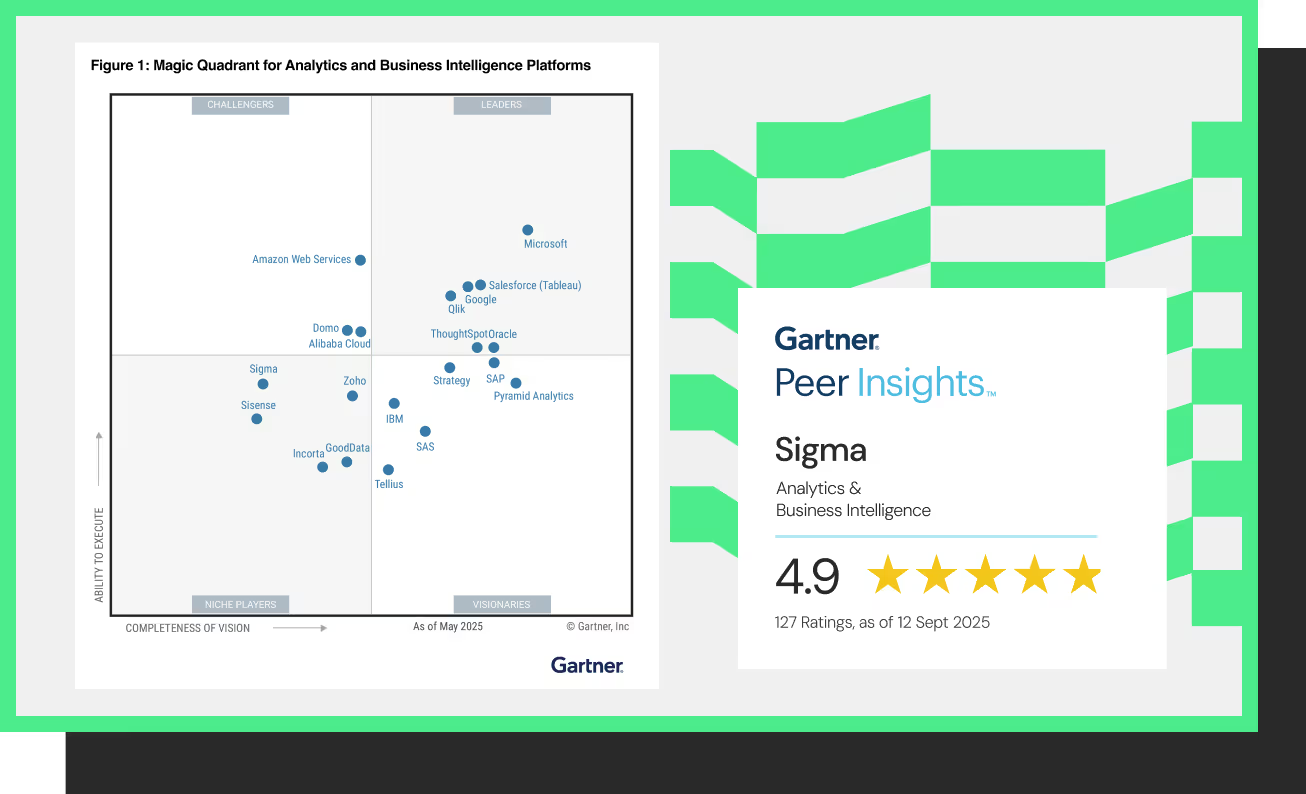Work with data in the spreadsheet format—and functions—you already know.
Don’t choose between speed-to-insight and scalability. Sigma dashboards get you both.
Know how to use a spreadsheet? Now you can build a data application.
Generate sustainable revenue by using Embedded Applications with Sigma to sell data as a product to your existing customers.
Top teams choose Sigma.
See for yourself. Sigma is a G2 crowd favorite, backed by countless reviews.
Verified User in Information Technology and Services

Design, generate, and distribute reports end-to-end at cloud scale.

Some flexible report design options if relevant data is pre-loaded into in-memory; advanced functionality requires Qlik Reporting (cloud) or Qlik NPrinting (on-prem) add-ons.

Flexible, intuitive UI with granular control and easy-to-understand interfaces.

Flexible dashboard creation; advanced customization requires more technical knowledge.

Cloud-native security with row- and role-level controls simplifies user management and compliance.

Access security features through Qlik Management Console (QMC); however, configuration and management across hybrid environments can be complex.

GUI-based semantic layer for governed access.

Proprietary associative data model supports a wide range of data relationships, but requires significant time and technical effort to learn.

Advanced tabular analysis and visualization on live data at cloud scale.

Ad-hoc analysis through Associative Engine, but limited by memory constraints for large datasets, and lacks advanced tabular analysis capabilities.

Enables dynamic data summarization and complex analysis. Easy multi-level groupings and customization.

Supports pivot tables, but large data sets or complex analysis can limit performance.

Detailed view of data origin and transformations; each element is a data source.

Includes native data lineage features via Qlik Cloud; Qlik Lineage Connector add-on needed to avoid limitations on how data is displayed across tools.

Built for the cloud; runs live queries on trillions of rows—no extracts.

Qlik Cloud scales at low data volumes, but larger datasets require more RAM per app, leading to higher costs and hard technical limits.

Built-in versioning tracks changes to everything, offering full history and granular reversion.

Lacks native version control in Qlik Cloud; admins must rely on 3rd-party systems, APIs, or Qlik Automate to create custom sync workflows.

Intelligent query engine built for cloud warehouses.

Sees fast performance through in-memory processing, but large-scale workloads are limited by available RAM and data refresh cycles.

Utilizes warehouse caching mechanisms to securely enhance performance, reduce query times, and avoid multiple copies of data.

Caches data in-memory and on disk, offering fast performance at low volumes. Doesn’t scale well and becomes costly for near real-time or large-scale needs.

Full white-label, live query embeds with interactive dashboards, write-back capabilities, and APIs. Native embed sandbox and quickstarts enable rapid development and deployment.

Basic iframe embedding; limited customization, no native live querying or write-back.

Spreadsheet UI uses familiar formulas — fast adoption with minimal training.

No spreadsheet interface; steep learning curve.

One-click, contextual drill down — no setup required.

Associative model supports flexible exploration; however, it’s not suited for structured, finance-style hierarchies common in enterprise reporting.

Write data back to the warehouse from the UI.

No native support; requires third-party extensions or custom development.

Write data back to the warehouse from the UI.

No native support; requires third-party extensions or custom development.

Direct, real-time queries from cloud data warehouses.

Supports live connections with heavy limitations, but most deployments rely on extracts and scheduled reloads; limits truly live data access.

Supports real-time collaboration while building data projects.

Supports real-time collaboration on data load scripts, but not for visual or dashboard editing.

Provides a robust SQL editor allowing analysts to do ad-hoc analysis and share results.

SQL is limited to data loading (ETL); user queries rely on complex proprietary syntax and cannot access advanced CDW capabilities (AI models, stored procedures, UDFs).

Integrates Python for scripting and advanced data analysis.

No native Python editing; integrations require external servers and complex setup.

Assistance and resources are accessible using live chat for all users within the platform.

Community and enterprise support available; no native in-product live chat with humans.

Includes data apps, AI agents (Ask Sigma), workflows, and write-back. Go beyond traditional dashboards.

No native support for app development and limited AI vision.
Top organizations choose Sigma. See for yourself.
































Read about Sigma's first-time recognition in this report.


Read the Blog


Read the Blog


Read the Blog
